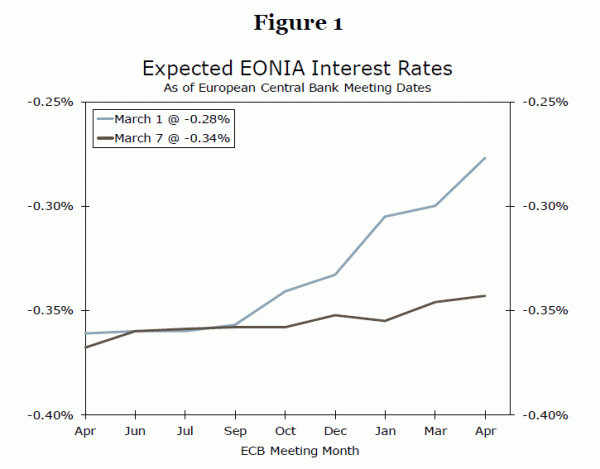Executive Summary
- The ECB made two key policy changes today. First, it pushed back its interest rate guidance to signal the first hike probably will not come this year. It also announced a new package of TLTROs, the terms of which were not as favorable as past offerings.
- The change in rate guidance was more of a surprise, in our view. In light of this new guidance, we are pushing back our forecast for the first ECB deposit rate hike to March 2020.
- We remain of the view that the direction of ECB policy over the medium term will be toward less accommodation, even if that process is delayed somewhat. That continues to support the case for a stronger euro versus the dollar over time, in our view, even if euro gains do not come until later this year.
What did the ECB Announce Today?
The European Central Bank (ECB) announced two key changes to its monetary policy stance today:
- New interest rate guidance that now suggests rates will remain ‘at present levels at least through the end of 2019.’
- A new package of Targeted Longer-Term Refinancing Operations (TLTROs). The ECB also cut its GDP and CPI forecasts. It now sees GDP growth of just 1.1% in 2019 (down from 1.7% previously), while it also cut its CPI forecasts (1.2% in 2019 vs. 1.6% previously, with cuts to 2020 and 2021 as well). The forecast cuts were generally anticipated, even if they were more significant than expected. However, the change in interest rate guidance and the new TLTROs were more of a surprise.
ECB Lends Banks a Hand
Let us first discuss the new TLTROs that were announced. As a reminder, TLTROs are essentially a means for the ECB to provide low-cost long-term funding to commercial banks in the Eurozone as a means of encouraging those banks to lend to the private sector, particularly to non-financial corporates. In a recent report, we said that if the ECB announced a new round of TLTROs at today’s meeting, it would probably be to send accommodative policy signals and spur more bank lending growth—Draghi’s comments largely confirmed that view. The terms of the new round of TLTROs are as follows:
- Maturity: Two years
- Interest rate: Indexed to the ECB refinancing rate over the life of the loan
We view these terms as less favorable for banks, at least compared to prior rounds of TLTROs. The last two rounds of TLTROs were offered at a rate fixed to the ECB refinancing rate at the time the loans were allotted. The terms on the new round of loans allow for the possibility for a bank’s funding costs to rise over the life of the loan if the central bank raises interest rates, something that was not a risk with the prior two rounds of loans. Moreover, the two-year maturity is less favorable than the four-year maturity offered by the first two rounds of TLTROs. Thus, while the act of offering TLTROs today was relatively accommodative in and of itself, the terms of these loans suggest the central bank wants to continue to provide support to banks but not at such favorable terms that they become overly reliant on this form of funding.
Rates: The Waiting is the Hardest Part
More surprising, in our view, was the ECB’s change in interest rate guidance. The central bank now sees rates ‘at present levels at least through the end of 2019,’ whereas previously it noted that rates would be steady ‘at least through summer 2019.’ In light of this change in guidance, we shift our call for the first ECB deposit rate hike to March 2020 (from December 2019 previously). The market pricing for short-term European interest rates also adjusted meaningfully, with markets now pricing in essentially no change in interest rates from the ECB over the next year or so (Figure 1).
While the ECB pushed back its rate guidance and announced new loans, this does not strike us as the start of a sustained shift toward easier monetary policy from the central bank. The terms of the new TLTROs are not particularly favorable compared to prior rounds of lending, and there was no talk of a possible rate cut or another round of asset purchases. To be sure, the domestic backdrop in the Eurozone remains challenging, as highlighted by the ECB’s forecast downgrades today. However, we do not see a looming recession for the Eurozone domestic economy, and expect a rebound in activity as the year progresses. If the Eurozone economy stabilizes as we expect and the ECB eventually raises rates, we would still look for the euro to rise over time, even if those eventual euro gains may not come until later this year.














